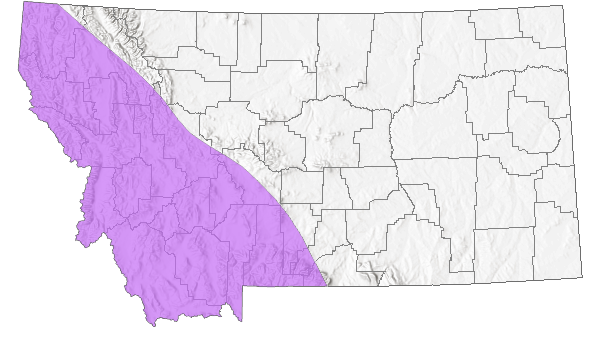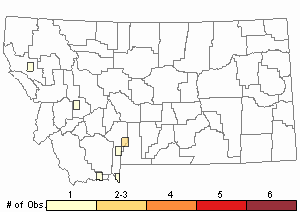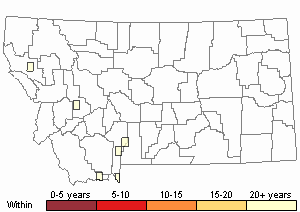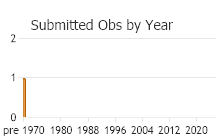View in other NatureServe Network Field Guides
NatureServe
Montana
Utah
Wyoming
Idaho
Wisconsin
British Columbia
South Carolina
Yukon
California
New York
Grass Shieldback - Steiroxys trilineata
Other Names:
Three-lined Shield-backed Katydid
General Description
The following comes from Caudell (1904), Hebard (1928), and Vickery and Kevan (1985). The head is small and deeply inserted into the pronotum (thorax) with small eyes. The pronotum is elongated posteriorly with the lateral lobes nearly as deep as long, with a curved margin, and distinct dorsal lateral and central carina (ridges), the former slightly diverging posteriorly, the latter straight. The lateral lobes of the pronotum are commonly bordered by yellowish, border with a black marking. Body colors are green or gray-brown (this being the most common). Both color forms often occur within the same population areas. Abdomen is plump, usually with a row of dark V-shaped black markings down the dorsal surface.
Note on the genera Steiroxys and Pediodectes
These two genera have never been studied in detail. Some of the other eight known species presently recognized may not be valid and others may still be awaiting discovery. This lack of study remains as current today as it did at the turn of the 20th century. Much of what is described here is very open to uncertainties, and in need of future diagnosis and discovery.
Calling song description
To date, no description nor sonograms have been reported.
Phenology
To date, no studies or observations have been found within the published literature, but speculated to be similar to other Shieldbacks in their adult stage.
Diagnostic Characteristics
The following is taken from Caudell (1904). The male pronotum length is 5.5-6 mm, and female is 4.5-6 mm. Hind femur length for males is 18-19 mm, and females 15.5-19 mm. The ovipositor length is 16-24 mm. The cerci of males (see illustration above) is somewhat flattened and tapering posteriorly to an inward curved point and possessing inside with an upward pointing tooth near the middle.
The Grass Shieldback can be confused and misidentified with
Stevenson’s Sheildback (
Pediodectes stevensonii), but unlikely with other Shieldbacked species, such as
Anabrus and
Peranabrus.
Species Range
Montana Range
Range Descriptions

 Native
Native
Range Comments
Occurs along the eastern front of the Rocky Mountain Range from south Alberta, south to northern Utah. It is mapped as a finger-like pattern from the eastern half of Idaho, eastward to western Montana. There are two isolated occurrences reported for north-central Oregon and western Nevada. In Montana, it has been reported in 3 counties (Walker SINA website 2020).
Observations in Montana Natural Heritage Program Database
Number of Observations: 9
(Click on the following maps and charts to see full sized version)
Map Help and Descriptions
Relative Density

Recency


 (Observations spanning multiple months or years are excluded from time charts)
(Observations spanning multiple months or years are excluded from time charts)
Habitat
This species prefers open grassy areas of sagebrush steppe and mountain meadows, favoring dry sites with sparse forbs and grasses growing on loose soils. It seems to favor sites ranging from 4,400 to 7,600 feet in elevation. The Grass Shieldback is not found commonly over its range, only as localized populations where individual numbers can be relatively high. This species is diurnal and best observed or collected during daylight hours (Hebard 1928, and Vickery and Kevan 1985).
Food Habits
To date, no studies or observations have been found within the published literature.
Reproductive Characteristics
To date, no studies or observations have been found within the published literature.
Stewardship Responsibility
References
- Literature Cited AboveLegend:
 View Online Publication
View Online Publication Caudell, A.N. 1907. The Decticinae (a Group of Orthoptera) of North America. Proceedings of the National Museum 32:285-410.
Caudell, A.N. 1907. The Decticinae (a Group of Orthoptera) of North America. Proceedings of the National Museum 32:285-410. Hebard, M. 1928. The Orthoptera of Montana. Proceedings of the Academy of Natural Sciences of Philadelphia, Vol. 80:211-306.
Hebard, M. 1928. The Orthoptera of Montana. Proceedings of the Academy of Natural Sciences of Philadelphia, Vol. 80:211-306. Vickery, V. R. and D. K. M. Kevan. 1985. The grasshopper, crickets, and related insects of Canada and adjacent regions. Biosystematics Research Institute, Ottawa, Ontario. Publication Number 1777. 918 pp.
Vickery, V. R. and D. K. M. Kevan. 1985. The grasshopper, crickets, and related insects of Canada and adjacent regions. Biosystematics Research Institute, Ottawa, Ontario. Publication Number 1777. 918 pp. Walker T.J.(ed.). 2020. Singing insects of North America. Accessed 10 February 2021. https://orthsoc.org/sina/
Walker T.J.(ed.). 2020. Singing insects of North America. Accessed 10 February 2021. https://orthsoc.org/sina/
- Additional ReferencesLegend:
 View Online Publication
View Online Publication
Do you know of a citation we're missing? Capinera, J.L., R.D. Scott, and T.J. Walker. 2004. Field Guide to Grasshoppers, Katydids, and Crickets of the United States. Ithaca, NY. Cornell University Press.
Capinera, J.L., R.D. Scott, and T.J. Walker. 2004. Field Guide to Grasshoppers, Katydids, and Crickets of the United States. Ithaca, NY. Cornell University Press. Fulton, B.B. 1933. Stridulating organs of female Tettigoniidae (Orthoptera). Entomological News XLIV:270-275.
Fulton, B.B. 1933. Stridulating organs of female Tettigoniidae (Orthoptera). Entomological News XLIV:270-275. Gwynne, D.T. 2001. Katydids and Bush-Crickets, Reproductive Behavior and Evolution of the Tettigoniidae. Ithaca, NY: Cornell University Press.
Gwynne, D.T. 2001. Katydids and Bush-Crickets, Reproductive Behavior and Evolution of the Tettigoniidae. Ithaca, NY: Cornell University Press. Scott, R.D. 2010. Montana Grasshoppers, Katydids, and Crickets A Pictorial Field Guide to the Orthoptera. MagpieMTGraphics, Billings, MT.
Scott, R.D. 2010. Montana Grasshoppers, Katydids, and Crickets A Pictorial Field Guide to the Orthoptera. MagpieMTGraphics, Billings, MT.
- Web Search Engines for Articles on "Grass Shieldback"
- Additional Sources of Information Related to "Insects"





